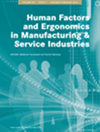期刊简介
Journal Title:Human Factors And Ergonomics In Manufacturing & Service Industries
The purpose of Human Factors and Ergonomics in Manufacturing & Service Industries is to facilitate discovery, integration, and application of scientific knowledge about human aspects of manufacturing, and to provide a forum for worldwide dissemination of such knowledge for its application and benefit to manufacturing industries. The journal covers a broad spectrum of ergonomics and human factors issues with a focus on the design, operation and management of contemporary manufacturing systems, both in the shop floor and office environments, in the quest for manufacturing agility, i.e. enhancement and integration of human skills with hardware performance for improved market competitiveness, management of change, product and process quality, and human-system reliability. The inter- and cross-disciplinary nature of the journal allows for a wide scope of issues relevant to manufacturing system design and engineering, human resource management, social, organizational, safety, and health issues. Examples of specific subject areas of interest include: implementation of advanced manufacturing technology, human aspects of computer-aided design and engineering, work design, compensation and appraisal, selection training and education, labor-management relations, agile manufacturing and virtual companies, human factors in total quality management, prevention of work-related musculoskeletal disorders, ergonomics of workplace, equipment and tool design, ergonomics programs, guides and standards for industry, automation safety and robot systems, human skills development and knowledge enhancing technologies, reliability, and safety and worker health issues.
中文简介
《制造与服务业中的人为因素和人体工程学》旨在促进有关制造业人为因素的科学知识的发现、整合和应用,并为这些知识的全球传播提供一个论坛,使其应用于制造业并使其受益。该期刊涵盖了广泛的人体工程学和人为因素问题,重点关注车间和办公环境中当代制造系统的设计、操作和管理,以追求制造敏捷性,即增强和整合人的技能与硬件性能,以提高市场竞争力、管理变更、产品和工艺质量以及人机系统可靠性。该期刊的跨学科性质使其涵盖了与制造系统设计和工程、人力资源管理、社会、组织、安全和健康问题相关的广泛问题。具体感兴趣的主题领域包括:先进制造技术的实施、计算机辅助设计和工程的人为因素、工作设计、薪酬和评估、选拔培训和教育、劳资关系、敏捷制造和虚拟公司、全面质量管理中的人为因素、预防工作相关的肌肉骨骼疾病、工作场所的人体工程学、设备和工具设计、人体工程学计划、工业指南和标准、自动化安全和机器人系统、人类技能发展和知识增强技术、可靠性以及安全和工人健康问题。
期刊点评
Human Factors And Ergonomics In Manufacturing & Service Industries创刊于1997年,由John Wiley and Sons Inc.出版商出版,收稿方向涵盖管理科学 - 工程:制造全领域,此刊是中等级别的SCI期刊,所以过审相对来讲不是特别难,但是该刊专业认可度不错,仍然是一本值得选择的SCI期刊 。平均审稿速度 约6.0个月 ,影响因子指数2.2,该期刊近期没有被列入国际期刊预警名单,广大学者值得一试。
中科院分区(数据版本:2023年12月升级版)
| 大类学科 | 分区 | 小类学科 | 分区 | Top期刊 | 综述期刊 |
| 工程技术 | 3区 | ENGINEERING, MANUFACTURING 工程:制造 ERGONOMICS 人体工程学 | 4区 4区 | 否 | 否 |
名词解释:
中科院分区也叫中科院JCR分区,基础版分为13个大类学科,然后按照各类期刊影响因子分别将每个类别分为四个区,影响因子5%为1区,6%-20%为2区,21%-50%为3区,其余为4区。
中科院分区(数据版本:2022年12月升级版)
| 大类学科 | 分区 | 小类学科 | 分区 | Top期刊 | 综述期刊 |
| 工程技术 | 4区 | ENGINEERING, MANUFACTURING 工程:制造 ERGONOMICS 人体工程学 | 4区 4区 | 否 | 否 |
中科院分区(数据版本:2021年12月旧的升级版)
| 大类学科 | 分区 | 小类学科 | 分区 | Top期刊 | 综述期刊 |
| 工程技术 | 4区 | ENGINEERING, MANUFACTURING 工程:制造 ERGONOMICS 人体工程学 | 4区 4区 | 否 | 否 |
中科院分区(数据版本:2021年12月基础版)
| 大类学科 | 分区 | 小类学科 | 分区 | Top期刊 | 综述期刊 |
| 工程技术 | 4区 | ENGINEERING, MANUFACTURING 工程:制造 | 4区 | 否 | 否 |
中科院分区(数据版本:2021年12月升级版)
| 大类学科 | 分区 | 小类学科 | 分区 | Top期刊 | 综述期刊 |
| 工程技术 | 4区 | ENGINEERING, MANUFACTURING 工程:制造 ERGONOMICS 人体工程学 | 4区 4区 | 否 | 否 |
中科院分区(数据版本:2020年12月旧的升级版)
| 大类学科 | 分区 | 小类学科 | 分区 | Top期刊 | 综述期刊 |
| 工程技术 | 4区 | ENGINEERING, MANUFACTURING 工程:制造 ERGONOMICS 人体工程学 | 4区 4区 | 否 | 否 |
WOS分区(数据版本:2023-2024年最新版)
| 按JIF指标学科分区 | 收录子集 | 分区 | 排名 | 百分位 |
| 学科:ENGINEERING, MANUFACTURING | SCIE | Q3 | 45 / 68 |
34.6% |
| 学科:ERGONOMICS | SSCI | Q2 | 12 / 24 |
52.1% |
| 按JCI指标学科分区 | 收录子集 | 分区 | 排名 | 百分位 |
| 学科:ENGINEERING, MANUFACTURING | SCIE | Q3 | 42 / 68 |
38.97% |
| 学科:ERGONOMICS | SSCI | Q3 | 16 / 24 |
35.42% |
名词解释:
WOS即Web of Science,是全球获取学术信息的重要数据库,Web of Science包括自然科学、社会科学、艺术与人文领域的信息,来自全世界近9,000种最负盛名的高影响力研究期刊及12,000多种学术会议多学科内容。给期刊分区时会按照某一个学科领域划分,根据这一学科所有按照影响因子数值降序排名,然后平均分成4等份,期刊影响因子值高的就会在高分区中,最后的划分结果分别是Q1,Q2,Q3,Q4,Q1代表质量最高。
CiteScore分区(数据版本:2024年最新版)
| CiteScore | SJR | SNIP | CiteScore排名 | ||||||||||||
| 5.2 | 0.678 | 1.012 |
|
名词解释:
CiteScore:衡量期刊所发表文献的平均受引用次数。
SJR:SCImago 期刊等级衡量经过加权后的期刊受引用次数。引用次数的加权值由施引期刊的学科领域和声望 (SJR) 决定。
SNIP:每篇文章中来源出版物的标准化影响将实际受引用情况对照期刊所属学科领域中预期的受引用情况进行衡量。
其他数据
| 是否OA开放访问: | h-index: | 年文章数: |
| 未开放 | 31 | 35 |
| Gold OA文章占比: | 2021-2022最新影响因子(数据来源于搜索引擎): | 开源占比(OA被引用占比): |
| 22.32% | 2.2 | 0.14... |
| 研究类文章占比:文章 ÷(文章 + 综述) | 期刊收录: | 中科院《国际期刊预警名单(试行)》名单: |
| 94.29% | SCIE、SSCI | 否 |
历年IF值(影响因子):
历年引文指标和发文量:
发文统计
2023-2024国家/地区发文量统计:
| 国家/地区 | 数量 |
| CHINA MAINLAND | 33 |
| South Korea | 19 |
| Taiwan | 17 |
| USA | 14 |
| Iran | 10 |
| England | 9 |
| Australia | 7 |
| GERMANY (FED REP GER) | 7 |
| Japan | 6 |
| Turkey | 5 |
2023-2024机构发文量统计:
| 机构 | 数量 |
| UNIVERSITY OF THE SUNSHINE COAST | 7 |
| TSINGHUA UNIVERSITY | 6 |
| CHUNG HUA UNIVERSITY | 4 |
| HUNAN INSTITUTE OF TECHNOLOGY | 4 |
| TIANJIN UNIVERSITY | 4 |
| TOKYO METROPOLITAN UNIVERSITY | 4 |
| UNIVERSITY OF SOUTHAMPTON | 4 |
| UNIVERSITY OF TEHRAN | 4 |
| KANAZAWA UNIVERSITY | 3 |
| NATIONAL TSING HUA UNIVERSITY | 3 |
相关期刊
| 同小类学科的其他优质期刊 | 影响因子 | 中科院分区 |
| Journal Of Energy Storage | 8.9 | 2区 |
| International Journal Of Ventilation | 1.1 | 4区 |
| Journal Of Environmental Chemical Engineering | 7.4 | 2区 |
| Chemical Engineering Journal | 13.3 | 1区 |
| Complexity | 1.7 | 4区 |
| Electronics | 2.6 | 3区 |
| International Journal Of Hydrogen Energy | 8.1 | 2区 |
| Aerospace | 2.1 | 3区 |
| Buildings | 3.1 | 3区 |
| Shock Waves | 1.7 | 4区 |
更多问题
免责声明
本站仅销售经国家新闻出版署批准的合法期刊,不是任何杂志官网,不涉及出版事务。本站仅提供有限咨询服务,需要用户自己向出版商投稿且没有绿色通道,是否录用一切以出版商通知为准。提及的第三方名称或商标,其知识产权均属于相应的出版商或期刊,本站与上述机构无从属关系,所有引用均出于解释服务内容的考量,符合商标法规范。本页信息均由法务团队进行把关,若期刊信息有任何问题,请联系在线客服,我们会认真核实处理。 若用户需要出版服务,请联系出版商:JOHN WILEY & SONS INC, 111 RIVER ST, HOBOKEN, USA, NJ, 07030。
